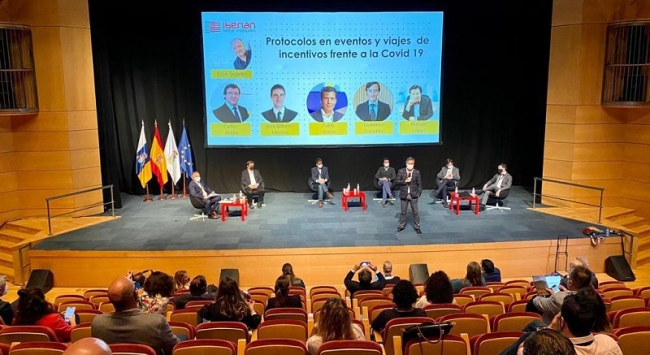
In these times of budgetary cuts, layoffs and, in short, the elimination of all that is superfluous, to talk about incentives could practically be taken as a provocation. However, one only has to forget the word’s purely recreational connotations, focusing instead on the value that this type of activity can bring to companies and their employees in the form of improved motivation and skills.
"How about organizing an incentive? At this precise moment, you’ve got to be kidding!"
With constantly shrinking budgets, planning an incentive is the last thing that springs to mind; yet, it is a good idea to step back and take a closer look at the current situation of most companies: layoffs, unending restructuring processes, and the constant need to adapt to new health, regulatory and business environments. All this can be grouped under the generic term "crisis".
In a situation such as this, it is important to remember that a company’s most valuable asset is still its people, a team under unremitting pressure, a product of the need to adapt and respond to successive changes. This is where the importance of factors such as attitude and teamwork come into play – requiring a level of motivation that has a direct impact on the quality of work and productivity – both of which are central to a company’s success.
Seen from another perspective, the issue could be addressed by asking the following question:
What is the use of an incentive?
Its definition, according to the dictionary, is a good starting point:
Incentive: a thing that motivates or encourages someone to do something.
Oxford Dictionary – All rights reserved
Beyond a purely recreational approach – the thing that motivates or encourages – it could also include initiatives that, adequately defined and executed, can have a direct impact on the motivation, attitudes, or skills that condition team results.
It is important to stress that an initiative of this type can encompass many forms and budgets. It is not necessary to take long-haul flights or hire a flashy venue to reach the established goals, since what is being measured is the experience and its impact on the participants, and this can achieved in many ways, depending on the goals.
Merely being able to leave the office space is a breath of fresh air, and an opportunity, however brief, to disconnect from daily chores and mix with colleagues in a more relaxed fashion while participating in a range of stimulating activities. These can also be educational, because an incentive can be geared to developing skills such as the resolution of problems, teamwork, leadership, time management, communication, and prioritizing urgency over importance. These skills, which are vital in the day-to-day functioning of any business, easily lend themselves to activities geared to their promotion and development. Activities can be entertaining or intense, active or passive, competitive or collaborative, for groups both big and small. All this, when suitably framed, can generate a huge amount of energy and the sensation of a shared achievement. It is not for nothing that it is sometimes held that a sandwich on a mountain summit tastes better than the pièce de resistance of a famous restaurant.
Although it is more common to approach incentives from an exclusively recreational perspective, given the current economic climate at Doctaforum we would like to propose, as a complementary alternative, an approach geared to achieving specific goals as a way of advocating and justifying incentives of this type.
The starting point – analysis of requirements and objectives
When planning an incentive, the first step is to establish its objectives so as to be able to define the format and the initiatives to be implemented in order to reach them. Then, taking into account the available budget, a final programme – including dates, duration, geographical destination, venue, and other logistic aspects – can be designed. Lastly, it is essential that the communication plan is considered throughout the process.
Objectives
A prior analysis makes it possible to define a set of initial objectives, which in turn will determine the actions required to reach them. These can be very varied, for instance:
- Is it necessary to promote greater collaboration/communication between specific departments?
- Is the aim to reward a joint achievement and encourage the next?
- Is the idea to integrate different groups in one large one?
- Are there any intra-departmental issues that need to be addressed?
- Is the aim to develop a set of specific skills?
- Is the aim to promote a creative environment for brainstorming and problem shooting?
For the objectives to be viable, all the departments involved in decision-making (HR, DGs, Sales, etc.) must be actively involved in this process. Only once the objectives have been defined as clearly as any other business objective will it possible to move on to the next step.
Format
Establishing an incentive’s format involves defining a global vision of the environment in which it will be staged. Some of the issues that should be addressed in this step are listed below:
- Is the event conditioned by any rules of professional conduct?
- Are there any conditioning factors as regards the participants that might limit options?
- Do the objectives lend themselves to an active or passive format?
- When is the best time to schedule the incentive?
- Is there any periodic event, such as a convention, into which the incentive can be incorporated?
- Is there any normally passive event, such as a corporate lunch/dinner, which could incorporate several active elements?
- Has the duration of the incentive been established?
- Are the objectives compatible or do they make it necessary to divide the initiative in some way?
- Are there any cultural aspects that should be taken into account? ?
- Is the incentive to be active/passive, individual/group, competitive/collaborative, etc.?
- Should the event include an intensely competitive part geared to obtaining results?
- And maybe another relaxed part keyed to promoting integration?
Initiatives
These are usually tailored to the specific needs of the participants, although other factors can also have an influence, such as corporate citizenship issues to which the company is committed, which can be addressed by including CSR or environmental initiatives.
Currently all the rage, corporate social responsibility (CSR) initiatives allow companies to harness staff collaboration so as to reflect the social values that they stand for.
Along the same lines, the growing commitment to environmental protection shown by many companies also provides them with new opportunities to reach specific objectives in this field (e.g., reforestation programmes).
In this case, a sound knowledge of the activities carried out by NGOs and social or civic organizations makes it possible to design creative experiences with plenty of value added, according to established objectives.
There is also a strong interest in showing commitment to patients through specific initiatives that heighten awareness and visibility of a disease or support programme, in addition to helping to raise funds for associations, which can not only mean real financial support for them but also a well-needed boost to their moral.
Another advantage of these initiatives can be their positive impact in the media, due to heightened public awareness. Likewise, it is also possible for companies to obtain greater returns on their investment in this type of CSR initiative by creating synergies with incentive programme content.
These initiatives not only reflect commitment but also at the same time encourage participants who can see the tangible results of their efforts. This can mean an extra motivation for them, while at the same time highlighting the company’s commitment to different causes.
In any case, whether conditioned or not by other possible considerations, there is plenty of room for creativity and innovation (even entertainment) when designing programmes keyed to reaching certain goals.
As an illustrative example, if the aim is to promote team spirit and the incentive has an active format, then an activity could be designed in which the participants have to solve a challenge within a time limit, such as building a raft to cross a lake or a broad range of outdoor activities. If the aim is to develop communication skills, then specific workshops could be designed which, beyond individual or group presentations, might also include other options, such as lip-dubs, flash mobs, filming activities, or competitions that harness the power of music to develop these skills.
Communication Plan
As with any ad campaign, a good communication plan is essential for ensuring active participation in and a full understanding of objectives by means of a series of initiatives geared to disseminating them and, as a result, heightening the awareness of the participants.
Before: pre-event communication initiatives allow participants to feel engaged. Different channels and formats can be used, both digital and paper-based, with the aim of transmitting messages progressively and periodically so as to generate buzz before the event. The definition of threads, themes and specific messages can be of great help to engage and attract the attention of all the stakeholders.
During: all the different aspects of the event, such as venues, dinners, transfers, activities, and even hotel rooms, lend themselves to a communication plan that makes the most of each opportunity or "touch point" to continuously transmit messages and objectives that reinforce and promote the immersion of the participants in a global experience.
After: the end of the event does not imply the end of the incentive. A clear plan that makes it possible to keep the event’s messages alive, once the participants have returned to their workplace, can help to prolong and consolidate their experience. This can achieved not only with a suitable communication plan that includes post-event initiatives, but also by implementing specific ones that allow the participants to review conclusions, decisions or lessons stemming from the experience.
The crisis as an opportunity?
In short, and taking into account the current "crisis", it is worth remembering the following maxim:
"In the middle of difficulty lies opportunity."
Albert Einstein
At Doctaforum, we are of the opinion that the measures businesses must take to overcome the complex current situation should not be limited to cutbacks and restructuring processes. Those initiatives that improve the intangible aspects of motivation, skills and team spirit, helping employees to adapt to the new normal, by means of reaching the established incentive objectives, should also form a part of this whole process.
The impact of these initiatives can be seen, for example, in post-event interaction when close proximity and shared experiences help to promote a greater sense of belonging and collaboration among the participants. The type of sporadic contact one has with someone from another department is not the same as socializing with the person during an incentive, collaborating together with him or her towards a common goal, maybe even winning a competition, or even sharing the experience of an entertaining evening together.
In short, incentives should be seen as an investment that, when combined with specific objectives, generate very real returns in the form of improved skills and greater team motivation which have a direct impact on communication, work quality and productivity, all of which are fundamental factors in the success of any company, whether or not there is a crisis on.
Federico Milian is marketing director of Doctaforum Scientific Congresses and Meetings. To contact him, email him at: federico_milian@doctaforum.com.





